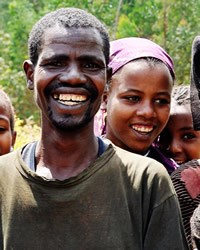Kambata in Ethiopia

Photo Source:
The Root Family
|
Send Joshua Project a map of this people group.
|
| People Name: | Kambata |
| Country: | Ethiopia |
| 10/40 Window: | Yes |
| Population: | 989,000 |
| World Population: | 989,000 |
| Primary Language: | Kambaata |
| Primary Religion: | Christianity |
| Christian Adherents: | 93.00 % |
| Evangelicals: | 79.94 % |
| Scripture: | Complete Bible |
| Ministry Resources: | Yes |
| Jesus Film: | Yes |
| Audio Recordings: | Yes |
| People Cluster: | Omotic |
| Affinity Bloc: | Horn of Africa Peoples |
| Progress Level: |
|
Introduction / History
The Kambata have a significant part in the history of Ethiopia both in terms of religious and cultural values. In Kebena Woreda, there are centuries-old mosques of "Katbare" and "Zebimola", which have a great place in Islamic religion followers. They were pioneers in expanding Islamic doctrine in the southern region of the country with the strong leadership of Hassen Enjamo (the king and Islamic ruler of the Kambata people) during the regime of Minillik II.
What Are Their Lives Like?
The Kambatas have an interesting culture that needs immediate attention to maintain its uniqueness. Their long history can serve as a source of original research for those in related disciplines and contribute to tourism development nationwide.
The Kambata nation has its own identity, dressing style, feeding habit, way of life, help culture, cooperation and dispute resolution mechanisms which are in bodies in their traditionally law known as "BobanI Geltita" and enforced by their traditional elder assembly/council called "Oget." The principle of Qebena traditional by-laws are believed to be adopted from Islamic law.
Mixed peasant agriculture is the main lifestyle of Kambata, involving the production of wheat, "teff," maize, sorghum, oil seed, chat, coffee and different fruits take most of their farms. Most of the farming is rain-feed despite the presence of potential river water throughout the year.
What Are Their Beliefs?
The vast majority of the Kambata are now Christian, especially Evangelical. They have the opportunity to share Christ with those who don't have a sufficient gospel witness.
What Are Their Needs?
Mixed agriculture and animal production are practiced at a subsistence level. They need intervention to increase productivity, food self-sufficiency and commercialization.
Prayer Points
Pray for their physical and spiritual needs to be met in such a way the Kambatas will give God the glory.
Pray for the Holy Spirit to move powerfully in their churches, drawing thousands to come closer to Jesus Christ.
Pray for the Lord to thrust out many as workers in the many neglected mission fields of Ethiopia.
Pray for Kambata disciples to make more disciples.